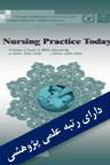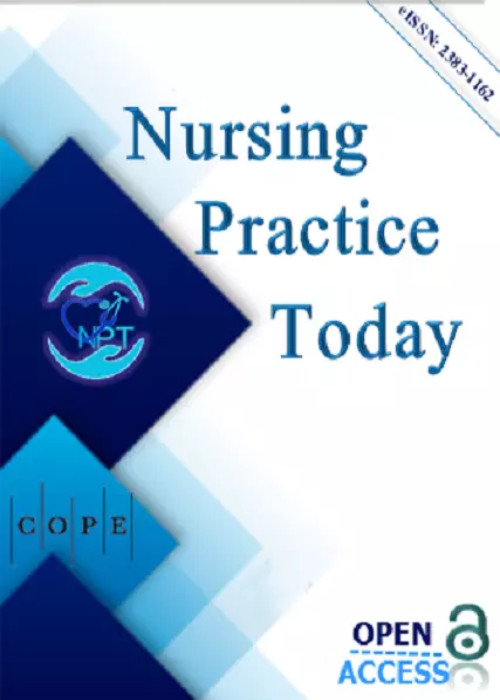فهرست مطالب

Nursing Practice Today
Volume:4 Issue: 2, Spring 2017
- تاریخ انتشار: 1396/04/05
- تعداد عناوین: 6
-
-
Pages 67-78Background and AimWhen choosing a profession, there are many factors that influence a persons decision, including the profession''s image, personal future plans, and the prospect of life-long success. In reference to the nursing profession, this decision is extremely important. This study aims, therefore, to determine the reasons why vocational high school students choose the nursing profession by examining their image perceptions and the future plans related to this choice.
Methods & Materials: This study was carried out with 352 nursing students who were selected from four medical vocational high schools in Istanbul. A demographic questionnaire and the Nursing Image Scale (NIS) were used for gathering data. For data analysis, percentages were calculated, and independent sample t-test and chi-square test were performed.ResultsThe average age of the students was 16.7±0.785, with most of the students being female (87.2%) and in their fourth year of attendance (42.6%). A majority of the students had chosen nursing for the ease of securing a job (46.9%), and a majority had a dream profession other than that of nursing but still related to the field of health (65.8%). NIS score averages of the second-year students were lower than those of both the third- and the fourth- year students (pConclusionOverall, it was determined that the majority of the participating students chose nursing for the purpose of easily securing a job, that the students held a negative perception of the profession and that the students had a dream profession other than that of nursing.Keywords: career choice, nursing, perception, students, education, health occupations -
Pages 79-86Background and AimTransferring critically ill patients from intensive care units to other wards is inevitable and may be associated with risks and complications for the patient. Therefore, the aim of this study was to examine the effect of training nurses through an interactive workshop on the quality of intra-hospital transfer of hospitalized patients in intensive care units.
Methods & Materials: In this quasi-experimental study, at first, the quality of intra-hospital transfer of patients from intensive care units were observed and assessed. Then, all the nurses working at these units participated in an interactive workshop. One month after the intervention, the quality of patients intra-hospital transfer was re-evaluated by a checklist. Finally, the collected data was analyzed using SPSS software version 16.ResultsResults of this study showed that the quality of most of the intra-hospital transfers was undesirable (66%) and none of the transfers was performed in a desirable level, while, 52% of them had desirable quality after the intervention. The mean score of the quality of patient transfer was significantly increased from 47.49±9.55 at the pre-intervention phase to 67.47±12.80 at the postintervention phase (PConclusionsAccording to the results, training nurses about the standards of intra-hospital patient transfer can improve the quality of intra-hospital transfer of critically ill patients that has not just become acceptable now and need to be improved. Therefore, to promote safe transfer of critically ill patients, it is recommended that nurses must undergo in-service training, especially as this subject does not exist in the formal nursing curriculum.Keywords: intra, hospital patient transfer, quality of care, intensive care unit, education -
Pages 87-95Background and AimMenopause is one of the natural phases of womens life. At this phase, due to the large fluctuations in hormones, undesirable physical, mental and sexual symptoms would occur that have negative effects on the quality of life of women. Due to the side effects of hormonal therapy, many women would prefer complementary medicine and especially herbal medicine. The present study was conducted to evaluate the effect of fennel on the quality of life in menopausal women.
Methods & Materials: This randomized triple-blind clinical trial was conducted on 90 menopausal women aged 45-60 years in Tehran. Participants were randomly allocated into two groups of fennel and placebo. The participants in the fennel group received oral soft capsules containing 100mg of fennel twice a day for 8 weeks and women in the placebo group received the same doze of placebo capsules containing 100mg of sunflower oil. The measured outcomes in the present study were the quality of life in menopausal women and its different aspects including vasomotor, socio-psychological, physical and sexual aspects which were measures using Menopause-Specific Quality of Life (MENQOL) questionnaire. Data were analyzed using SPSS14.ResultsAfter 8 weeks of intervention, covariance analysis showed a significant difference in the score of quality of life and its four measured aspects between the two studied groups (for quality of life, vasomotor aspect, physical aspect and socio-psychological aspect: pConclusionsThe present study showed that the fennel could decrease the symptoms of menopause with no serious side effects and consequently improve menopausal womens quality of life.Keywords: fennel, quality of life, menopause -
Pages 96-102Background and AimAs a social destructive phenomenon, substance abuse causes malfunction of the family structure and, most importantly, behavioral problems and stress for children. This study was conducted to compare the parental communication patterns and self-esteem between adolescents with addicted parents and the control group.
Methods & Materials: In this descriptive-analytical study, 200 adolescents with addicted parents and healthy parents, from the same residential region, were selected by random sampling. Data collection tool was the Parental Communication Patterns Scale, and Coopersmith Self-Esteem Inventory. Data were analyzed by SPSS 20 using chi-square test and independent t-test.ResultsThe mean age of the adolescents was 14.5±2.5 years in the case group, and 15.04±2.4 in the control group. Independent t-test indicated that the control group''s mean score of self-esteem was significantly higher than the case groups (PConclusionIn light of the current study''s results, it is recommended to run communication patterns and their effects on family members'' mental health courses for families with parental substance abuse.Keywords: family communication patterns, self, esteem, adolescents, addict, opium -
Pages 103-111Background and AimNurses intention to leave their job is problematic for health system and the quality of work life is one of the important factors affecting this intention. The present study was aimed to show the nurses quality of work life and its components, their intention to leave the job, and the relation between nurses quality of work life and their intention to leave the job.
Methods & Materials: This cross-sectional study was conducted on a sample of 300 nurses in teaching hospitals of Kurdistan University of Medical Sciences which were selected through census method. Waltons quality of work life (1988) questionnaire and intention to leave questionnaire designed by Rusbelt et al (1980) were used to collect the data. SPSS 16 software, analytical and descriptive statistics, and statistical tests such as ANOVA, Tukey''s HSD test, Independent T-Test and Pearson''s correlation coefficient were used to analyze the data.ResultsThe results showed that 61% of nurses had low levels of work life quality and 39.7% of the nurses intended to leave their job. Intention to leave job was significantly related to the employment status (P=0.01) and gender (P=0.03). Also, there was a significant and inverse correlation between the quality of work life components and intention to leave the job (P=0.0001).ConclusionsNursing administrators must adopt effective strategies to create favorable working conditions under which nurses work life quality in different aspects would be improved. To prevent the nurses from leaving their job, nursing managers should administer interventions to improve the atmosphere of organization that affect the components of working life quality.Keywords: workplace, employee turnover, nurses


